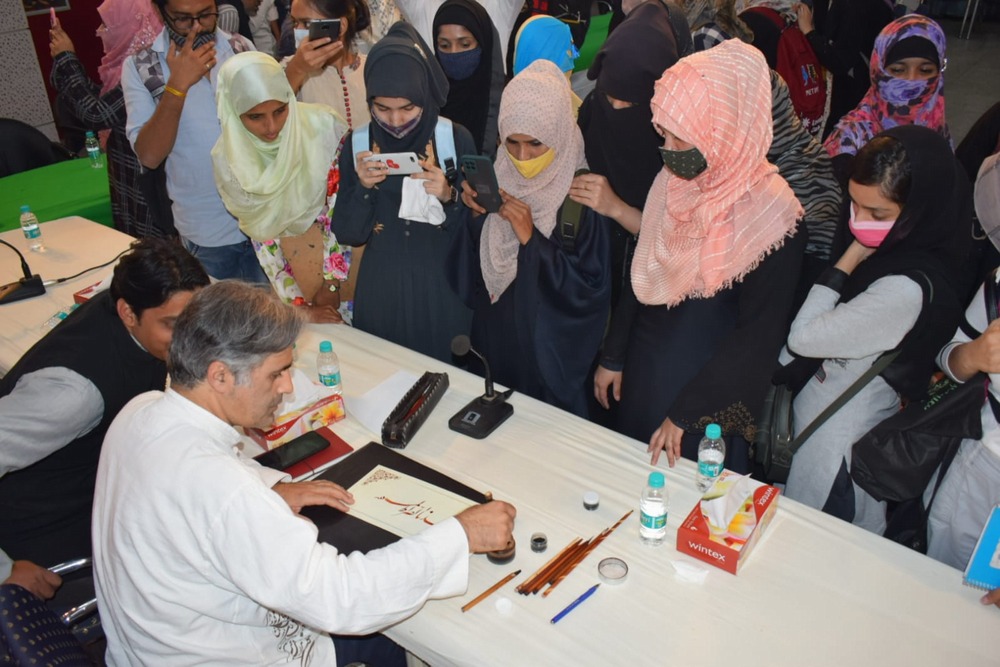Calligraphy link with Persian & Urdu Culture & Literature along with the Calligraphy Workshop & Exhibition

An event to review the link between calligraphy Persian, Urdu language & Culture was held on November 3rd, 2021 in the presence of professors and students of the College of Art of Delhi University, Urdu calligraphy researchers and students of some Islamic schools in Delhi.
An event to review the link between calligraphy Persian, Urdu language & Culture was held on November 3rd, 2021 in the presence of professors and students of the College of Art of Delhi University, Urdu calligraphy researchers and students of some Islamic schools in Delhi.
In this program, Dr. Mohammad Ali Rabbani, Cultural Counselor Iran in New Delhi, Dr. Ehsanullah Shokrollahi, Director, Persian Research Center, ICH, New Delhi, Massoud Rabbani, Prominent Iranian Calligrapher, Mr. Mushtaq Ahmad and Mr. Ikramullah, two Indian calligraphers & Professor Akhlaq Ahan, Persian Department Jawaharlal Nehru University, New Delhi spoke about the characteristics of calligraphy and its linkages with Persian and Urdu culture and literature.
Rabbani in this meeting, while explaining the significance of art in both western and eastern views said that Art having various types of definitions. In Greek philosophy and in Plato's view, art is considered as a mere technique and imaginary perception of phenomena.
He added that in the Eastern view, especially in Iran and India, art was closely related to religion and was interpreted as a spiritual tool. He explained the place of art in Islam.
Dr. Shokrollahi, another speaker at the meeting, raised the question of whether calligraphy is a science or an art. Calligraphy We need to know a lot about it and calligraphy is an art because it seeks beauty. He emphasized that the art of calligraphy during its 1400 years history of Islam has reflected the highest aspects of human thought and spiritual dimensions. He spoke about Calligraphy and its relationship with Iranian Islamic culture and civilization.
Prof. Alhlaq Ahan In his speech, emphasized that calligraphy has a deep connection with human civilization, gave a brief history of calligraphy and said that Qazvin is one of the important centers of calligraphy in Iran and Mir Damad is one of the famous calligraphers in Iran and in Homayoun's time. The art of calligraphy flourished in India because Homayoun had been studying calligraphy in Qazvin for some time. And his son Akbar also established a translation center, and its refinement and calligraphy were done by Indian artists, copies of which are still available in Indian libraries today. In another part of his speech, he said: "Different regions of India have played a role in the prosperity of calligraphy and their style has become famous, such as Bihari calligraphy or monasteries that created their own style, which is known as them."
Mushtaq Ahmad, an Indian calligrapher, also emphasized in his speech that the Nasta'liq script is for Iranians and is taught in the same way in India. He went on to introduce calligraphy training centers in Delhi.
Dr. Massoud Rabbani was another speaker at the meeting. He called love the divine gift from which art is born. Existential philosophy of art is to create love and affection between human beings. Among all the arts, the art of calligraphy is a spiritual ar. The eighth Nasta'liq script was written in two styles in Iran.
In the final part of the program, Mr. Masoud Rabbani, Mr. Shokrollahi and Mr. Masoud Rabbani, along with 2 Indian calligraphers, taught calligraphy to the interested parties and showed examples of their calligraphy. In this program, which is also from social networks Art and calligraphy students from Delhi University, the Urdu Academy schools were present.
Choose blindless
Red blindless Green blindless Blue blindless Red hard to see Green hard to see Blue hard to see Monochrome Special MonochromeFont size change:
Change word spacing:
Change line height:
Change mouse type:

_1.jpeg)
_1.jpeg)
_1.jpeg)